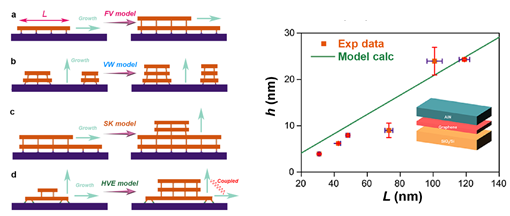Nobel Prize winner in Physics, H. Kroemer, said "The interface is the device." Therefore, interfaces hold significant research value in material growth and property control. For traditional thinfilm growth, it can be classified into Frank-Van der Merwe (FV), Volmer-Weber (VW), and Stranski-Krastanov (SK) modes, mainly based on the interaction strength between thinfilm and substrate. In the FV mode, due to the lattice matching between the thinfilm and substrate, in-plane growth is dominant. In contrast, in the VW mode, there is a significant lattice mismatch, which results in a larger resistance to in-plane growth, replaced by an out-of-plane growth. The SK mode is a growth mode that lies between these two. Over the past century, these three growth modes dominate the growth process of almost all the thinfilms on substrates. Recently, experiments have shown that by using two-dimensional materials, such as graphene, as a buffer layer, it is possible to grow high-quality nitride thinfilms on van der Waals substrate. However, this growth mode cannot be simply explained by these three established modes mentioned above, which has also sparked debates in the field.
In a recent study, Prof. Huang in collaboration with the other researchers made a key step towards understanding this puzzling growth mechanism. Taking the growth of aluminum nitride (AlN) thinfilm on graphene as an example, they have used multiscale computation to study the growth of AlN thinfilm on graphene. Simulations revealed a new type of bonding at the interface between the AlN and graphene: only the corners have strong chemical bonds, while the center has weak van der Waals interactions. Interestingly, this hybrid bonding mode makes the growth mode distinct from the traditional FV mode, named as hybrid van der Waals epitaxy (HVE). In this new growth mode, growth in-plane and out-of-the plane are strongly coupled and satisfies certain physical constraints. To confirm the validity of HVE, we have performed the experimental confirmation. Importantly, experimental collaborators have also verified the correctness of this growth mode through multiple experimental methods, such as AFM and SEM. Overall, this work expands the established growth modes and proposes a new growth mechanism beyond the current category of material growth, which may be adopted design high-quality nitride semiconducting thinfilms with different height-size-shape correspondence.
This work has recently been published in Physical Review Letters [1]. In addition, this work is also selected as the Editors’ Suggestion.

Figure: A new growth model: hybrid van der Waals epitaxy (HVE). HVE is fundamentally different from other known growth models, in which the in-plane and out-of-plane growth is strongly coupled.
Reference:
L. Hu, D. Liu, F. Zheng, X. Yang, Y. Yao, B. Shen, B. Huang, Hybrid van der Waals Epitaxy, Phys. Rev. Lett. 33, 046102 (2024) (Editors’ Suggestion).



